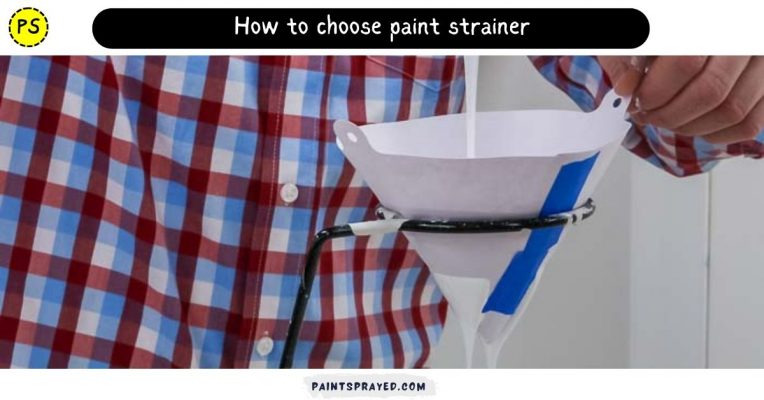A good paint strainer is a vital part of the painting process. If you want to paint a smooth wall, you need the right tools to achieve that.
This guide will help you How to choose a paint strainer topic for your painting and I will teach you how to choose it and how to use it properly so you don’t mess up.
As you know I have experience in painting which will help you in understanding and my experience will help you a lot if you are a beginner.
How to choose paint strainer?
What is a paint strainer?
A paint strainer is a small, fine-mesh strainer that is used to remove any lumps or debris from paint before using it.
This helps to ensure a smooth, even application of paint and prevents any clogging of the paintbrush or other applicator.
Why are paint strainers important?
Paint strainers are important because they help to remove any debris or lumps that may be present in the paint.
This ensures that the paint will have a smooth, even finish when applied to your surface.
Strainers also help to prevent clogs in your painting equipment, which can save you time and money in the long run.
Types of paint strainers
There are a few different types of strainers, the most common being the mesh strainer. This type of strainer is great for general straining and sifting purposes.
Another type of strainer is the chinois, which is a cone-shaped strainer that is often used for straining stocks and sauces.
Finally, there is the tea strainer, which is a small mesh strainer that is designed specifically for straining tea leaves.
Bag strainer
A bag paint strainer is a tool used to remove unwanted debris from paint before it is applied to a surface. This helps to ensure a smooth, even finish.

The strainer is a bag made of fine mesh material that is placed over the paint can or bucket. The paint is then poured through the strainer into another container.
Any debris that is caught in the mesh is discarded.
Cone strainer
A cone paint strainer is a type of strainer that is cone-shaped and typically used to strain paint.
These strainers are placed over the opening of a paint can and help to remove any debris or clumps that may be present in the paint.
This type of strainer is also often used when pouring paint into a container, such as a paint bucket, to help ensure a smooth and even flow.
Pump strainer
Pump paint strainers are a type of strainer that is used to remove paint from a pump. They are typically made of mesh or screen material and are designed to fit over the inlet of a pump.
Paint strainers are used to prevent clogs and damage to the pump by removing paint chips, debris, and other contaminants from the paint before it enters the pump.
How to use paint strainer?
A strainer is a kitchen tool that is used to remove solids from liquids. There are many different types of strainers, but they all work in essentially the same way.
To use a strainer, simply place it over a bowl or other container and pour the liquid to be strained through it.
The strainer will catch any solids in the liquid and allow the liquid to pass through, leaving the solids behind.
How do you size a strainer?
To size a strainer, you will need to consider the following factors:
- The size of the pipe or opening that the strainer will be installed in
- The flow rate of the liquid or gas that will be passing through the strainer
- The size of the particles that you want to remove from the liquid or gas
You should choose a strainer that is the same size as the pipe or opening, or slightly larger.
The strainer should be able to handle the flow rate of the liquid or gas without becoming clogged or restricting flow.
Finally, the strainer should have a mesh or screen that is small enough to remove the particles you want to filter out, but not so small that it becomes clogged easily or restricts flow.
It is generally a good idea to choose a strainer with a higher flow rate rating than the actual flow rate you expect to see.
To allow for potential increases in flow rate or to allow for some degree of clogging without affecting performance.
How many microns is a paint strainer?
A paint strainer is typically made of a fine mesh material that is designed to remove impurities, such as dirt, debris, and lumps, from paint before it is applied to a surface.
The size of the mesh in a paint strainer is usually measured in microns.
However, the size of the mesh can vary depending on the type of paint and the desired level of filtration.
For example, some paint strainers have meshes with openings that are 50 microns in size, while others have meshes with openings that are as small as 25 microns.
To give you an idea of how small a micron is, a human hair is about 75 microns in diameter.
What size strainer is best?
The size of the strainer that is best for a particular application will depend on the type of paint and the desired level of filtration.
In general, a strainer with a smaller mesh size will be more effective at removing impurities from the paint, but it may also be more prone to clogging.
If you are using a paint with a lot of fine particles or lumps, a strainer with a smaller mesh size may be a good choice.
For example, you might use a strainer with a mesh size of 25 microns or 50 microns for this type of paint.
On the other hand, if you are using a paint with fewer impurities, a strainer with a larger mesh size may be sufficient.
Ultimately, the best strainer for your needs will depend on the specific requirements of your project.
It may be helpful to consult with a paint supplier or manufacturer to determine the most appropriate strainer size for your specific needs.
Which is finer 10 or 20 micron?
A 10 micron strainer is finer than a 20 micron strainer.
The size of the mesh in a strainer is measured in microns, and a smaller micron size indicates a finer mesh.
A 10 micron strainer has openings that are smaller in size than a 20 micron strainer, which means it is more effective at trapping smaller particles.
For example, a 10 micron strainer might be used to filter out very fine particles or impurities from a liquid.
Such as paint or engine oil, while a 20 micron strainer might be used to remove larger particles or debris.
It’s worth noting that the size of the mesh in a strainer can vary depending on the specific application and the desired level of filtration.
In some cases, a finer strainer may be necessary to remove smaller particles, while a coarser strainer may be sufficient for removing larger particles.
FAQ’s of How to choose paint strainer
Conclusion of how to choose paint strainer
I hope you enjoyed this post on how to choose a paint strainer!
I know it can be difficult to know how to choose the right paint strainer, especially when there are so many different products available.
I hope this guide has been able to help you choose the right paint strainer for your project and that your painting goes smoothly!
If you have any questions about choosing paint strainers, please comment down here and I will reply as soon as possible.

Matthew Edward is a professional painter who loves to paint and wants to share useful tips and tricks which he had learned in many years of experience in painting. He also used many products that can be used for painting he has tried and tested each and every product to give an unbias opinion about it in his review. This blog is very useful for those newbies who want to learn painting without making mistakes.






